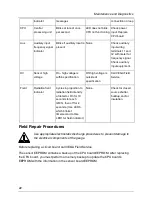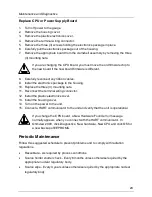
Setup and Calibration
Select Linearity
The majority of density applications use the equation linearizer to calculate the process
value. For density applications, the equation is the default and we recommend it in most
circumstances. If the results from the equation linearizer method are not satisfactory,
contact VEGA Field service to explain the other options. The linearizer equation
calculates a density reading for a given count reading at the detector. To make the
correct calculation, it relies on the following information:
•
Vessel’s inner diameter system parameter
•
Span settings parameter
•
Source type parameter
•
Data used in the initial calibration
•
Absorption co-efficient
For information on linearity options, see the
DSGH Installation and Operation Guide
.
1.
Click
Setup
,
Gauge Setup
,
Linearizer Type
.
2.
Click
Equation
.
Calibrate Gauge
To calibrate your gauge, you must complete the
Standard Method (2-point)
or the
Two-Point Process Calibration
steps.
Standard Method (2-point)
1.
Set the low density and collect
Cal Low
data.
2.
Set the high density and collect
Cal High
data.
3.
Collect the linearizer table data.
4.
Calculate the linearity.
5.
Calculate the calibration.
6.
Perform the data collection steps in any sequence, depending on your ability to
empty and fill the vessel.
To perform a calibration you must complete the following:
1.
Click
Equation
from the
Setup
,
Gauge Setup
tab.
2.
Check that the parameters (vessel inner diameter, engineering units, measurement
span, and source type) are correct.
3.
Start the gauge 4 hours before start of calibration.
4.
Fill vessel or pipe with process.
5.
Prepare to draw a sample while the gauge is collecting data.
6.
Measure a process sample with the density gauge and enter the actual density.
12
Summary of Contents for DSGH
Page 2: ......
Page 4: ...Notes NOTES 4...
Page 6: ...Notes NOTES 6...
Page 14: ...Notes NOTES 14...
Page 24: ...Notes NOTES 24...
Page 26: ...Notes NOTES 26...
Page 27: ......



























